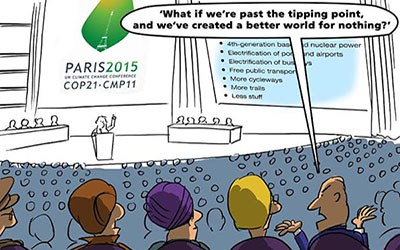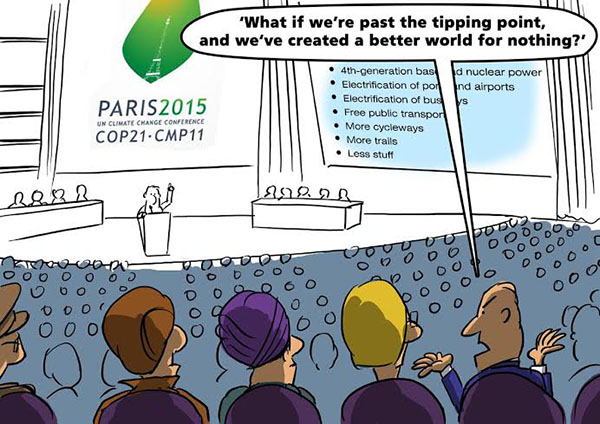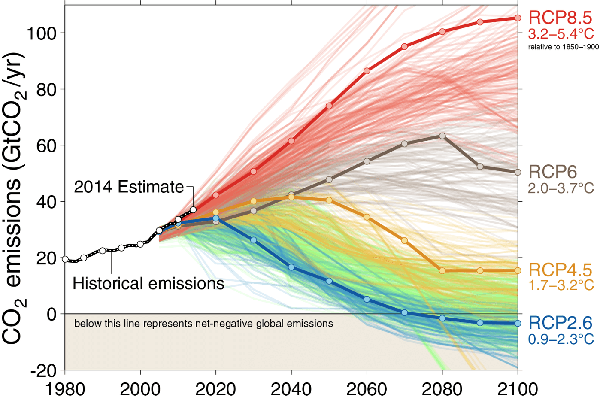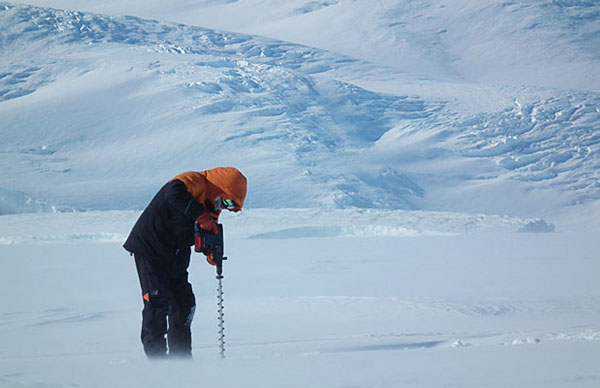How trail can help save a habitable planet


Twenty-One Conferences Later: After just 10 United Nations Climate Change Conferences, cartoonist Joel Pett has a delegate asking ‘What if it’s a big hoax and we create a better world for nothing?’ Eleven years on, not even big oil is suggesting that global warming is a hoax, but is still more than happy to bank the profits from feeding the world’s fossil-fuel addiction. Meanwhile, feedbacks such as from diverse sources of Arctic methane—mankind is caught in a monkey trap of its own making. cartoon Majorlook Productions
The Pulitzer Prize-winning Guardian is throwing everything at it.
Well, nearly everything. While its ‘Keep it in the ground’ campaign is all over its environment section, there is no trace, on the newspaper’s main online masthead, of the millennial moral issue.
Last month the Guardian bravely determined to continuously feature anthropogenic global warming through to the United Nations Climate Change Conference, in December. On the face of it, the newspaper, with its focus on preventing the production of fossil fuels, rather than their use, is pinpointing exactly what United Nations climate conferences have been getting wrong for 20 years, through their failure to challenge the freedom of corporations to pour as much fuel on the global warming fire as they choose.
Where the Guardian’s campaign is wholly inadequate, however, is in respect to ‘the agreed safe level of warming of 2°, and to meaningful alternatives to fossil fuel use. There are two searing issues with 2°, and the notion of a budget of burnable fossil fuels. The first is that 2° is a political target, not a scientifically determined safe margin beyond which dangerous anthropogenic global warming will occur. It is probable that the dangerous threshold is no more than 1°, but judging by the rapid release of Artic methane already occurring at 0.85° of warming, it is entirely possible that a critical tipping point has already been exceeded, and that is the second issue: There is no soundly based budget of fossil fuel that can safely be burned, given that only time will tell whether or not the quantity that could be burned without precipitating dangerous global warming has already been exceeded.
The groupthink that has allowed so many, from the United Nations to the Guardian, to adhere to an it’s-alright-it’s-not-too-late-to-fix-this-thing message, is, aside from being unscientific, ultimately counterproductive—it fatally squanders the imperative for urgency. Arctic sea ice extent, on 9 April, for example, was at a record low for that date, and is poised to be further excoriated by warm water delivered by the Gulf Stream, whose sea surface temperature, off the Gulf of Maine, on 10 April, was an anomalous 12.5° warmer. Yet the event received no discernible mainstream media mention. Given the consequences of a sea-ice-free Arctic summer, the mainstream media should be front-paging such milestones along, or down, the Arctic death spiral.

Worst-Case Scenario: Despite 23 years of climate conferences, the world is stubbornly adhering to the Intergovernmental Panel on Climate Change’s worst-case, +8.5-Watts-per-square-metre-radiative-forcing-by-2100, trajectory. Anything close to the 3.2°–5.4° global temperature rise of that scenario would render many regions functionally uninhabitable. Almost every environmentalist including Bill McKibben, meantime, rather than lose face by publicly re-evaluating the desperate need for more nuclear power, would prefer to risk a habitable planet. chart Fuss et al. 2014
Regarding the other shortcoming of the Guardian’s campaign: the failure to ventilate realistic alternatives to continued fossil fuel use. The comforting message that permeates the campaign is of stories hyping wind and photovoltaic power generation growth-rates. While this might be music to the ears of the converted, it only serves to reinforce the suspicion by those less gullible that the global warming issue has been greenjacked by renewables proponents, regardless of how unrealistic their preferred, anti-nuclear-power, preferences are. Through its abandonment of nuclear power and embrace of renewables, Germany now needs to burn more than half of its forestry output to just to provide baseload power. Given the drastic need to reduce its steel and cement production, given their contribution to greenhouse gas emissions, wood needs to be used for high-quality, long-lasting products, not ruinously burned. Green parties gleefully champion World’s-best-known-climate-scientist James Hansen, but not his unequivocal message that, with solar and wind energy still only contributing about 3% of global energy supply, nuclear power is a climate-action necessity.
Antarctic climate scientist New Zealander Dr Daniel Price is so exercised by the need for urgency that he is cycling from the ‘Pole to Paris’ to help raise awareness of dangerous global warming. The term climate change, he says, doesn’t portray the scale of the problem. This situation demands a wartime-scale mobilisation, yet far too few are demanding it. Many who are fully aware of the enormity of what humanity faces, including, it sometimes seems, any who are also behavioural phycologists, are fearful of being frank lest their audience is stunned into inaction. Their message is to appeal to the values of their audience; climate action disguised as protection of those things the target audience holds dear. On that basis, the Mahurangi Coastal Trail is a veritable climate action exemplar. Firstly it will protect the sense of splendid isolation that Te Muri Beach affords—if the threatened access by road was permitted, that precious essence would instantly evaporate. Secondly, the trail, by making one magnificent regional park out of three smaller ones, will considerably add to the depth of wilderness experience for all park users, whether they use the trails to reach the more remote parts of the park, or picnic within metres of a car park. Thirdly, the trail will form a short but critical piece of a missing link in Te Araroa that would surely become its most-used and most-loved by Aucklanders: the Pūhoi–Wenderholm section, with its panoramic coastal vistas from the Te Muri ridgeline farm trail. Fourthly, the trail will appeal to New Zealanders’ strong sense of social justice, in that regardless of means, those with access to the metropolitan transport system can readily ride to Waiwera and step into a 900-hectare regional park.
Meantime, a significant audience consists of those who are strongly motivated by the moral issue of the millennium. While a recreational trail might not readily be seen as front-line climate action, it is probably far more so in fact than buying a Tesla, or installing photovoltaic panels. The trail, potentially, could epitomise the radical reimagining of modern lifestyles that will be necessary if there is to be even a fighting chance that comprehensive climate chaos can be averted. Since the United Nations Framework Convention on Climate Change was signed 23 years ago, greenhouse gas emissions not only have not been scaled back, but have increased, and there is no indication that Paris will see them slashed despite the escalating evidence demanding rapid response. But even if anthropogenic greenhouse gas emissions ceased overnight, that leaves the global thermostat stuck at 400 parts per million of carbon dioxide, a whopping 143% of the pre-industrial level. Stuck means 75% of carbon dioxide will remain in the atmosphere for centuries, and 25% will remain for millennia. This makes a mockery of the political construct that countries have a collective budget they can agree, or not, to divvy up between themselves in Paris.

Fed-Up with Climate Change: New Zealand climate scientist Dr Daniel Price, who is currently cycling to the climate conference in Paris, says the term climate change is inadequate to describe ‘the scale of the problem’. His boots-on-the-ice work in Antarctica involved physically checking ice thickness to verify measurements made by satellite-based instruments. image Canterbury University
All of this means that humanity has to get its head around the gargantuan dual challenge of rebuilding a high-carbon civilisation as a low-carbon one, without precipitously adding to the fossil fuel use that underpins almost every human activity. And if that is not a definition of impossibly, humanity also needs to be making heroic efforts to claw down the thermostat by removing carbon dioxide from the atmosphere, but particularly to intercept the runaway release of Arctic methane, without which all other climate action is increasingly academic. To be successful, this unprecedented existential struggle demands that every individual, every community, every business, but particularly, every corporation, participates in a collaborative practicable response that is a million miles away from anything being contemplated for Paris. The Mahurangi community can play to its strengths by building a trail that could connect Aucklanders, by public transport, to 900 hectares of coastal regional parkland. By doing so, it could make a contribution every bit as important as hosting a baseload low-carbon power plant, because developed countries must not only switch to low-carbon electricity, but also reduce material consumption given the high embedded carbon in most manufactured items. Parks, public libraries and art galleries, along with free public transport and a fully funded health service are prerequisites of a richly non-materialistic alternative to the tail-eating serpent civilisation has become. It is also the simultaneous duty of the developed to help developing countries out of energy poverty, via a low-carbon route.
If climate scientists could unequivocally state that climate chaos will ensue when atmospheric carbon dioxide hits concentrations 50% higher than pre-industrial levels—420 parts per million, which could occur within seven years—politicians worldwide would have an unimpeachable mandate to decree an immediate mobilisation for climate action. But because greenhouse gases have never been ramped up this high this quickly ever before, there is no paleoclimate analogue for what will happen as mankind continues with its audacious, unplanned experiment. Through chronic under-funding, climate scientists can’t even monitor the experiment sufficiently closely to be able to know when low-end runaway greenhouse effect kicks in, if it hasn’t already done so. Nor would governments know what an effective climate action mobilisation might look like, except there would be no shortage of global corporations offering no end of geoengineering fixes, many of which could equate to hauling on the handbrake of an already skidding car.
Rather than wait for irrefutable evidence of the need for desperate measures, the time for heroic climate action is now. The butt of Joel Pett’s 11-year-old climate cartoon asks:
What if it’s a big hoax and we create a better world for nothing?
Long since, it has warranted updating, to ask:
What if we’re not that close to dangerous climate change, and we create a better world too soon?’

Auckland Transport No-Brainer: With the very overdue extension and electrification of the Northern Busway, Auckland could rub Wellington’s nose in its ill-informed and costly—$20 million and rising just to remove the overhead wires—decision to replace 75% fossil-fuel-free energy with diesel-powered buses. The hundreds of these new-generation—they run on battery power alone for manoeuvring and parking—Foton trolleybuses being added to Beijing’s transport system will see air quality improve in that capital city… With their left-side doors, these buses would only require the drive-by-wire driver’s seat to be shifted to the right to be suitable for busways in Aotearoa. image Transira
Sadly, today’s update calls for something altogether more confronting, at which point the device ceases to serve the original purpose of ridiculing the disinformed whilst providing succour to the green-jobs-and-renewable-energy faithful. But given that climate action roadmaps are generally an insipid mishmash of the impracticable and ineffective, comfort is last thing that should be on offer. Just as in the ninth month of World War II, blood, toil, tears and sweat is all any leader grounded in climate-science should be offering today, and, after 23 years of (failed) United Nations climate conferences, no aspiring politician has any excuse for being less than comprehensively informed.
With its potential to turbocharge the first non-urban leg of Te Araroa north of the metropolis, the Mahurangi Coastal Trail can play a pivotal part in convincing New Zealanders to see their motu as more than just a place to parade materialism. Te Araroa can be more than just a trail. It can be a network of trails that crisscross Aotearoa to accommodate, in places, everything from pushchairs to horse-drawn carriages. It also can be for more than recreation. It can be for walking to work, or riding home from home from school on horseback, as was commonplace as recently as half a century ago.
Unlike the in-most-part just war against the Third Reich, the ensuing struggle, if it is to be won, will be won because all of humanity is on the same side, working to protect, feed and shelter the most vulnerable of its number from the ravages of an increasingly capricious climate, and from rapidly retreating shorelines.
In addition to the blood, sweat and tears promised by Winston Churchill, as with World War II, there will also be hope, love and laughter, and then, as now, victory never a certainty.
Meantime, overwhelming support for the Mahurangi Coastal Trail ensures that battle will be won.
